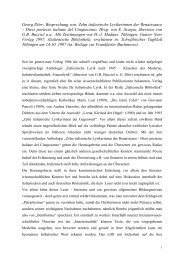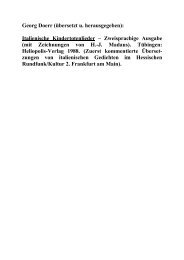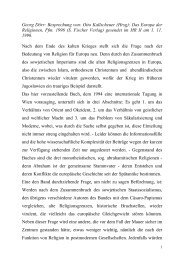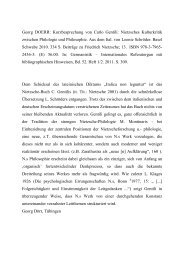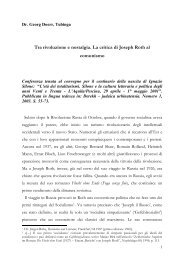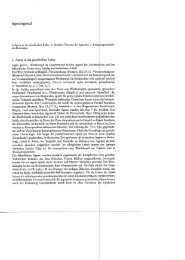Dr. Georg Doerr -- Rezensionen von: Muttermythos und Herrschaftsmythos -- Zur Dialektik der Aufklärung bei den Kosmikern, Stefan George, Walter Benjamin und in der Frankfurter Schule. 2., erweiterte Auflage (eBook, 410 S.) K&N: Wuerzburg 2019.
Aus der Rezension von Prof. Dr. Adrian Daub, STANFORD University: ... Thankfully, however, even if the book’s argument and organi-zation betray its origins as a German Habilitationsschrift, it must have been an exceptionally well-written one. Doerr’s style is ext-remely readable throughout, and the previously mentioned tan-gents are much less distracting than they could have been, thanks to the author’s engaging and lucid prose. The two metho-dological introductions keep the readers oriented in the dizzying and shifting terrain. ... Aus der Rezension von Prof. Dr. Jacques Le Rider, Directeur d’études an der École pratique des Hautes Études, Section des Sciences historiques et philologiques in PARIS: ... Die Eloge des Matriarchats war übrigens nie ein Zeugnis von Frauenverehrung. Der Otto Weininger-Kult von Karl Kraus zeigt, dass ein hoher Grad an Misogynie und Antifeminismus mit mutterrechtlichen Diskursfiguren kompatibel ist. Eine andere Geschichte der Moderne seit Rousseau ließe sich als Geschichte der Krisen der Männlichkeit und der Matriarchats-Mythenbil-dung schreiben. In diesem Rahmen hätte die hervorragende Arbeit von Georg Doerr eine zentrale Bedeutung. ... Aus der Rezension von Prof. Dr. Gabriele Guerra, Università degli studi di ROMA 'La sapienza': ... Allo studioso non digiuno delle complicate traiettorie che solcano il panorama intellettuale tedesco di quest’epoca, il libro offre quindi una miniera quasi inesauribile di fonti, spunti, costellazioni inedite e riarticolazioni di altre già note, sempre fermamente incardinate intorno a una ricognizione della misura in cui tutte queste figure concettuali si sono confrontate con il mito della madre da un lato, con quello della signoria dall’altro – due mitologemi del potere, insomma, che permettono di capire non solo posizionamenti e riarticolazioni intellettuali tra Reich guglielmino e repubblica di Weimar, ma anche i caratteri pro-fondi dell’identità tedesca ricca e frastagliata di quell’epoca. ... Auf meiner Homepage: https://georgdoerr.net/ sind die zahlreichen Rezensionen, die zur Erstauflage des Buches erschienen sind, zu finden (siehe: georgdoerr.net/rezensionen), sowie Informationen zu meinem, um es vorsichtig auszu-drücken, 'eigenartigen' Promotionsverfahren; siehe dazu die Seite: https://georgdoerr.net/rezensionen/ad-wissenschaftliche-gutachten-zu-muttermythos-und-herrschaftsmythos/
Aus der Rezension von Prof. Dr. Adrian Daub, STANFORD University:
... Thankfully, however, even if the book’s argument and
organi-zation betray its origins as a German Habilitationsschrift,
it must have been an exceptionally well-written one. Doerr’s style is ext-remely
readable throughout, and the previously mentioned tan-gents are much
less distracting than they could have been, thanks to the author’s
engaging and lucid prose. The two metho-dological introductions keep
the readers oriented in the dizzying and shifting terrain. ...
Aus der Rezension von Prof. Dr. Jacques Le Rider, Directeur d’études an der École pratique des Hautes Études, Section des Sciences historiques et philologiques in PARIS:
... Die Eloge des Matriarchats war übrigens nie ein Zeugnis von Frauenverehrung. Der Otto Weininger-Kult von Karl Kraus zeigt, dass ein hoher Grad an Misogynie und Antifeminismus mit mutterrechtlichen Diskursfiguren kompatibel ist. Eine andere Geschichte der Moderne seit Rousseau ließe sich als Geschichte der Krisen der Männlichkeit und der Matriarchats-Mythenbil-dung schreiben. In diesem Rahmen hätte die hervorragende Arbeit von Georg Doerr eine zentrale Bedeutung. ...
Aus der Rezension von Prof. Dr. Gabriele Guerra, Università degli studi di ROMA 'La sapienza':
... Allo studioso non digiuno delle complicate traiettorie che solcano il panorama intellettuale tedesco di quest’epoca, il libro offre quindi una miniera quasi inesauribile di fonti, spunti, costellazioni inedite e riarticolazioni di altre già note, sempre fermamente incardinate intorno a una ricognizione della misura in cui tutte queste figure concettuali si sono confrontate con il mito della madre da un lato, con quello della signoria dall’altro – due mitologemi del potere, insomma, che permettono di capire non solo posizionamenti e riarticolazioni intellettuali tra Reich guglielmino e repubblica di Weimar, ma anche i caratteri pro-fondi dell’identità tedesca ricca e frastagliata di quell’epoca. ...
Auf meiner Homepage: https://georgdoerr.net/ sind die zahlreichen Rezensionen, die zur Erstauflage des Buches erschienen sind, zu finden (siehe: georgdoerr.net/rezensionen), sowie Informationen zu meinem, um es vorsichtig auszu-drücken, 'eigenartigen' Promotionsverfahren; siehe dazu die Seite: https://georgdoerr.net/rezensionen/ad-wissenschaftliche-gutachten-zu-muttermythos-und-herrschaftsmythos/
Sie wollen auch ein ePaper? Erhöhen Sie die Reichweite Ihrer Titel.
YUMPU macht aus Druck-PDFs automatisch weboptimierte ePaper, die Google liebt.
<strong>Rezensionen</strong> <strong>von</strong> <strong>Dr</strong>. <strong>Georg</strong> <strong>Doerr</strong>: <strong>Muttermythos</strong> <strong>und</strong><br />
<strong>Herrschaftsmythos</strong> -- <strong>Zur</strong> <strong>Dialektik</strong> <strong>der</strong> <strong>Aufklärung</strong> um<br />
die Jahrh<strong>und</strong>ertwende <strong>bei</strong> <strong>den</strong> <strong>Kosmikern</strong>, <strong>Stefan</strong> <strong>Georg</strong>e<br />
<strong>und</strong> <strong>in</strong> <strong>der</strong> <strong>Frankfurter</strong> <strong>Schule</strong>. Würzburg: Königshausen<br />
& Neumann 2007<br />
HINWEIS: E<strong>in</strong>e zweite, verbesserte <strong>und</strong> ergänzte <strong>Auflage</strong> des <strong>in</strong>zwischen<br />
vergriffenen Buches (1. <strong>Auflage</strong>, Juli 2007) ist im März 2019 als <strong>eBook</strong> mit<br />
dem geän<strong>der</strong>ten (Unter-)Titel: „<strong>Muttermythos</strong> <strong>und</strong> <strong>Herrschaftsmythos</strong> – <strong>Zur</strong><br />
<strong>Dialektik</strong> <strong>der</strong> <strong>Aufklärung</strong> <strong>bei</strong> <strong>den</strong> <strong>Kosmikern</strong>, <strong>Stefan</strong> <strong>Georg</strong>e, <strong>Walter</strong><br />
<strong>Benjam<strong>in</strong></strong> <strong>und</strong> <strong>in</strong> <strong>der</strong> <strong>Frankfurter</strong> <strong>Schule</strong>“ wie<strong>der</strong> im Verlag Königshausen<br />
& Neumann erschienen, <strong>410</strong> Seiten. ISBN-10: 3826080386, ISBN-13:<br />
9783826080388.<br />
Kurzbesprechung <strong>von</strong> Prof. <strong>Dr</strong>. Ra<strong>in</strong>er Kolk, Bonn. In: GERMANISTIK –<br />
Internationales Referatorgan mit bibliographischen H<strong>in</strong>weisen, Band 48<br />
(2007) Heft 3-4, S. 885.<br />
<strong>Georg</strong> Dörr: <strong>Muttermythos</strong> <strong>und</strong> <strong>Herrschaftsmythos</strong>. <strong>Zur</strong> <strong>Dialektik</strong> <strong>der</strong><br />
<strong>Aufklärung</strong> um die Jahrh<strong>und</strong>ertwende <strong>bei</strong> <strong>den</strong> <strong>Kosmikern</strong>, <strong>Stefan</strong> <strong>Georg</strong>e <strong>und</strong> <strong>in</strong><br />
<strong>der</strong> <strong>Frankfurter</strong> <strong>Schule</strong>. Würzburg: Königshausen & Neumann. 2007. 380 S.<br />
(Epistemata: Reihe Literaturwissenschaft 588), ISBN-10 3-8260-3511-<br />
9/3826035119 - ISBN-13 978-3 -8260 -3511-1 / 9783826035111.<br />
Im Durchgang durch Philosophie-, Literatur- <strong>und</strong> Religionsgeschichte seit <strong>der</strong> <strong>2.</strong><br />
Hälfte des 19. Jh. rekonstruiert <strong>der</strong> Band die Evokation <strong>der</strong> mythischen<br />
Konzeption e<strong>in</strong>es universalen Mutterrechts zunächst <strong>in</strong> <strong>der</strong> Münchner Kosmik<br />
(<strong>Schule</strong>r, Klages, Wolfskehl u. Derleth), <strong>bei</strong> <strong>Stefan</strong> <strong>Georg</strong>e <strong>und</strong> se<strong>in</strong>em Kreis<br />
sowie schließlich <strong>bei</strong> <strong>Walter</strong> <strong>Benjam<strong>in</strong></strong> <strong>und</strong> <strong>in</strong> Adorno/Horkheimers <strong>Dialektik</strong><br />
<strong>der</strong> <strong>Aufklärung</strong> (hier <strong>in</strong>sbes. im Odyssee-Kap.); als Vorläufer wer<strong>den</strong> Bachofen<br />
<strong>und</strong> Nietzsche e<strong>in</strong>bezogen (die Antike-Rezeption <strong>und</strong> bes. die<br />
Gegenüberstellung dionysisch/apoll<strong>in</strong>isch stehen hier im Zentrum). Die<br />
Entwürfe <strong>der</strong> Kosmiker, <strong>den</strong>en es um die Wie<strong>der</strong>erweckung archaischer Vorzeit<br />
zu tun ist <strong>und</strong> <strong>der</strong> <strong>in</strong>strumentalisierende Zugriff <strong>Georg</strong>es, <strong>der</strong> die Überw<strong>in</strong>dung<br />
des weiblichen Pr<strong>in</strong>zips als Prämisse <strong>der</strong> ‘geistigen Zeugung’ e<strong>in</strong>es<br />
charismatisch geführten Männerb<strong>und</strong>es sieht, wer<strong>den</strong> mit <strong>Stefan</strong> Breuer als<br />
f<strong>und</strong>amentalistische Religionsstiftungen verstan<strong>den</strong>. In <strong>der</strong> ‘<strong>Frankfurter</strong> <strong>Schule</strong>’<br />
wer<strong>den</strong> strukturell analoge Formen <strong>der</strong> Mythenrezeption ermittelt: Versuche <strong>der</strong><br />
1
Integration mythischer Elemente <strong>in</strong> e<strong>in</strong>e gr<strong>und</strong>sätzlich an <strong>der</strong> Idee <strong>der</strong><br />
<strong>Aufklärung</strong> orientierten Kulturphilosophie.<br />
Rezension <strong>von</strong> Prof. <strong>Dr</strong>. Adrian Daub, Stanford University, <strong>in</strong>: Focus on<br />
German Studies, VOL. 15, August 2008.<br />
<strong>Georg</strong> Dörr: <strong>Muttermythos</strong> <strong>und</strong> <strong>Herrschaftsmythos</strong>. <strong>Zur</strong> <strong>Dialektik</strong> <strong>der</strong><br />
<strong>Aufklärung</strong> um die Jahrh<strong>und</strong>ertwende <strong>bei</strong> <strong>den</strong> <strong>Kosmikern</strong>, <strong>Stefan</strong> <strong>Georg</strong>e <strong>und</strong> <strong>in</strong><br />
<strong>der</strong> <strong>Frankfurter</strong> <strong>Schule</strong>. Würzburg: Königshausen & Neumann. 2007. 380 S.<br />
(Epistemata: Reihe Literaturwissenschaft 588), ISBN-10 3-8260-3511-<br />
9/3826035119 - ISBN-13 978-3-8260 -3511- 1 / 9783826035111.<br />
This book explores the jo<strong>in</strong>t reception of Johann Jakob Bachofen and Friedrich<br />
Nietzsche <strong>in</strong> the early 20th century, a reception characterized, accord<strong>in</strong>g to the<br />
author, by a dialectic between the titular <strong>Muttermythos</strong> and<br />
<strong>Herrschaftsmythos</strong>. Put another way, <strong>Georg</strong> Dörr’s study charts the vagaries<br />
of the conceptual pair Dionysian/ Apollonian <strong>in</strong> the wake of Nietzsche and<br />
Bachofen. Dörr first lays out the configuration Bachofen Nietzsche, which<br />
<strong>in</strong>augurates the myth of an antique matriarchate brought to heel by a pr<strong>in</strong>ciple<br />
of dom<strong>in</strong>ation, then traces the tangled reception of this constellation through<br />
th<strong>in</strong>kers on both the reactionary side of the spectrum (<strong>in</strong> particular Ludwig<br />
Klages, Alfred <strong>Schule</strong>r, <strong>Stefan</strong> <strong>Georg</strong>e and Ludwig Derleth) and on the<br />
Marxist side (the Frankfurt School, and <strong>Walter</strong> <strong>Benjam<strong>in</strong></strong>). It is precisely this<br />
ideological range that Dörr wants to expla<strong>in</strong>: why could the reactionary neopaganism<br />
of the turn of the century, the Marxist critics of the 30s and 40s, and<br />
mo<strong>der</strong>n-day fem<strong>in</strong>ism all draw on the same strange philosopheme?<br />
It was Bachofen who first <strong>in</strong>troduced the idea of an orig<strong>in</strong>al matriarchate <strong>in</strong> his<br />
1861 book on Das Mutterrecht. Dörr is <strong>in</strong>terested only <strong>in</strong> those th<strong>in</strong>kers who<br />
attempt to comb<strong>in</strong>e Bachofen’s narrative with the Nietzschean critique of<br />
culture (rather than, say the n<strong>in</strong>eteenth-century reception of Bachofen<br />
<strong>in</strong>depen<strong>den</strong>t of Nietzsche, such as Engels, for example), basically graft<strong>in</strong>g<br />
Bachofen’s term<strong>in</strong>ology onto the historical narrative of the “Socratic”<br />
transition from Dionysian to Apollonian laid out <strong>in</strong> Nietzsche’s Birth of<br />
Tragedy (Bachofen draws on the same pair of concepts, but to different ends).<br />
Dörr acknowledges immediately that this is of course a flagrant misread<strong>in</strong>g of<br />
Nietzsche, and that Bachofen’s archeology of the matriarchate <strong>in</strong> no way<br />
celebrates the orig<strong>in</strong>al “Dionysian” fem<strong>in</strong><strong>in</strong>e rule whose existence it<br />
postulates. Nevertheless, when Karl Wolfskehl first <strong>in</strong>troduced Ludwig Klages<br />
to Bachofen’s work, and when Klages eventually <strong>in</strong>spired <strong>Benjam<strong>in</strong></strong>’s read<strong>in</strong>g,<br />
the premises were decidedly post-Nietzschean.<br />
Somewhat puzzl<strong>in</strong>gly, Dörr presents the Kosmiker’s legacy <strong>in</strong> the Frankfurt<br />
School before actually delv<strong>in</strong>g <strong>in</strong>to the Kosmikerkreis itself. The reason for<br />
this seems to lie <strong>in</strong> the fact that with Wolfskehl’s circle two new aspects<br />
2
entered <strong>in</strong>to the reception of Bachofen and Nietzsche: homoeroticism and<br />
community. The latter was if anyth<strong>in</strong>g absolutized <strong>in</strong> the <strong>Georg</strong>e-circle’s<br />
Maxim<strong>in</strong>-cult, which Dörr, much like the Thomas Karlauf’s recent biography<br />
of <strong>Georg</strong>e, construes as a response to the challenges posed by the Kosmikerprogram.<br />
However, whereas the Kosmikerkreis (<strong>in</strong> particular Klages)<br />
<strong>und</strong>ertook to rescue the Dionysian from Appol<strong>in</strong>ian encroachment, the<br />
Maxim<strong>in</strong>-cult revolved aro<strong>und</strong> a male eroticism fo<strong>und</strong>ed on the supercession<br />
or dom<strong>in</strong>ation of the Dionysian. Accord<strong>in</strong>g to Dörr, the repression of the<br />
maternal that animates this <strong>Herrschaftsmythos</strong> is of one piece with the<br />
political utopia of the circle or or<strong>der</strong>, an emphatically homoerotic category<br />
somewhere between the family and the community.<br />
Like much recent scholarship on <strong>Georg</strong>e, Dörr is exceptionally adept at cutt<strong>in</strong>g<br />
through generations of (self-)mystification on the part of <strong>Georg</strong>e and his<br />
disciples, and manages to contextualize the different stages of his work quite<br />
effectively. And unlike Manfred Frank’s Gott im Exil, for example, Dörr’s<br />
book is attuned to the nuances that dist<strong>in</strong>guish the mysticism of the cosmics<br />
and the <strong>in</strong>ner-wordly transcen<strong>den</strong>ce of the <strong>Georg</strong>e-circle — <strong>in</strong> other words the<br />
fact that <strong>Georg</strong>e’s homoerotic B<strong>und</strong> was explicitly conceived as an Apollonian<br />
figure (was, to use Dörr’s term<strong>in</strong>ology, a th<strong>in</strong>g of <strong>Herrschaftsmythos</strong>) —<br />
which sheds an <strong>in</strong>terest<strong>in</strong>g light on the homoerotic politics of the early<br />
nationalists <strong>in</strong> Germany.<br />
Dörr’s book suffers from a problem common to many German books that<br />
beg<strong>in</strong> life as (barely) adapted dissertations or Habilitationsschriften: a<br />
sprawl<strong>in</strong>g encyclopedism, where str<strong>in</strong>gent argumentation is called for, and an<br />
<strong>in</strong>ability to let go of a tangent simply because it distracts from the matter at<br />
hand. As a result, the narrative and argumentative thrusts wane at several vital<br />
junctures, as the author pauses to address questions like whether the Kosmiker<br />
are proto-fascists – <strong>in</strong>terest<strong>in</strong>g and important, to be sure, but not necessary <strong>in</strong><br />
the general flow of the argument. The book is also relentless <strong>in</strong> <strong>in</strong>clud<strong>in</strong>g<br />
(often without lay<strong>in</strong>g out <strong>in</strong> any detail) scholarly arguments aro<strong>und</strong> the<br />
<strong>Georg</strong>e- circle or the Kosmiker, which are little more than a Literaturüberblick<br />
cunn<strong>in</strong>gly <strong>in</strong>terspersed <strong>in</strong>to the ma<strong>in</strong> text, and which prove quite <strong>in</strong>trusive.<br />
Particularly distract<strong>in</strong>g is the book’s organizational system – label<strong>in</strong>g a section<br />
“8.4.3” may once have been quite helpful <strong>in</strong> guid<strong>in</strong>g Dörr’s Doktorvater<br />
through the text, but as the rea<strong>der</strong> of a book one expects, well, a book, not a<br />
spreadsheet. Thankfully, however, even if the book’s argument and<br />
organization betray its orig<strong>in</strong>s as a German Habilitationsschrift, it must have<br />
been an exceptionally well-written one. Dörr’s style is extremely readable<br />
throughout, and the previously mentioned tangents are much less distract<strong>in</strong>g<br />
than they could have been, thanks to the author’s engag<strong>in</strong>g and lucid prose.<br />
The two methodological <strong>in</strong>troductions keep the rea<strong>der</strong>s oriented <strong>in</strong> the<br />
dizzy<strong>in</strong>g and shift<strong>in</strong>g terra<strong>in</strong>. Dörr quotes extensively but judiciously and is<br />
exemplary <strong>in</strong> contextualiz<strong>in</strong>g the texts he addresses. The sections on <strong>Benjam<strong>in</strong></strong>’s<br />
reception of the constellation Klages-<strong>Georg</strong>e show Dörr very familiar with<br />
3
current scholarship on the orig<strong>in</strong>s of the Frankfurt School, and he teases out<br />
this strange trajectory with great clarity. Overall, there is little to criticize<br />
about Dörr’s excellent study, short of a few cosmetic organizational issues.<br />
This book is a welcome addition to the <strong>in</strong>tellectual history of the sexual and<br />
national politics of f<strong>in</strong>-de-siècle avant-gardes. Although it is published <strong>in</strong> a<br />
series dedicated to Literaturwissenschaft, Dörr’s book addresses ma<strong>in</strong>ly<br />
questions of <strong>in</strong>tellectual history – his read<strong>in</strong>gs of <strong>Georg</strong>e, for <strong>in</strong>stance, do not<br />
go particularly far beyond, for <strong>in</strong>stance, Karlauf’s recent biography of the<br />
poet. But <strong>Georg</strong>e’s historical position is of course <strong>in</strong>terest<strong>in</strong>g enough – as<br />
Manfred Riedel made clear last year <strong>in</strong> his Das geheime Deutschland. In the<br />
English-speak<strong>in</strong>g world <strong>in</strong> particular, where the Kosmikerkreis rema<strong>in</strong>s still<br />
rather <strong>und</strong>erexplored (short of a few passages <strong>in</strong> Robert Norton’s Secret<br />
Germany), Dörr’s book constitutes a much-needed addition to the scholarly<br />
literature. Researchers <strong>in</strong>terested <strong>in</strong> the Frankfurt School, too, should f<strong>in</strong>d<br />
Dörr’s book a boon, s<strong>in</strong>ce it traces an <strong>in</strong>terest<strong>in</strong>g l<strong>in</strong>eage (from Klages via<br />
<strong>Benjam<strong>in</strong></strong> to Adorno and Horkheimer), that emphasizes the often<br />
<strong>und</strong>eracknowledged fact that mid-20th century Marxism drew on a range of<br />
conservative th<strong>in</strong>kers, adapt<strong>in</strong>g them for their own purposes.<br />
Rezension <strong>von</strong> Prof. <strong>Dr</strong>. Jacques Le Ri<strong>der</strong>, Directeur d’études an <strong>der</strong> École<br />
pratique des Hautes Études, Section des Sciences historiques et philologiques<br />
<strong>in</strong> Paris. In: Zeitschrift für Germanistik XIX – 2/2009. S. 449.<br />
<strong>Georg</strong> Dörr: <strong>Muttermythos</strong> <strong>und</strong> <strong>Herrschaftsmythos</strong> -- <strong>Zur</strong> <strong>Dialektik</strong> <strong>der</strong><br />
<strong>Aufklärung</strong> um die Jahrh<strong>und</strong>ertwende <strong>bei</strong> <strong>den</strong> <strong>Kosmikern</strong>, <strong>Stefan</strong> <strong>Georg</strong>e <strong>und</strong> <strong>in</strong><br />
<strong>der</strong> <strong>Frankfurter</strong> <strong>Schule</strong> (Epistemata: Reihe Literaturwissenschaft, Bd. 588),<br />
Königshausen & Neumann, Würzburg 2007, 380 S. ISBN-10 3-8260-3511-<br />
9/3826035119 ISBN-13 978- 3-8260-3511-1/9783826035111.<br />
Diese Philosophie-, literatur- <strong>und</strong> religionsgeschichtliche Ar<strong>bei</strong>t <strong>von</strong> GEORG<br />
DÖRR über die Mutterrechtstheorien, -Mythen <strong>und</strong> -Phantasien seit Bachofen<br />
<strong>und</strong> Nietzsche beschäftigt sich <strong>in</strong>sbeson<strong>der</strong>e mit <strong>den</strong> Münchner <strong>Kosmikern</strong><br />
(<strong>Schule</strong>r, Klages, Wolfskehl, Derleth), mit <strong>Stefan</strong> <strong>Georg</strong>e <strong>und</strong> se<strong>in</strong>em Kreis <strong>und</strong><br />
schließlich mit <strong>Walter</strong> <strong>Benjam<strong>in</strong></strong> <strong>und</strong> Adorno/Horkheimers <strong>Dialektik</strong> <strong>der</strong><br />
<strong>Aufklärung</strong>.<br />
Den <strong>Kosmikern</strong> g<strong>in</strong>g es vor allem um die Fasz<strong>in</strong>ation <strong>der</strong> archaischen Vorzeit.<br />
<strong>Georg</strong>e stellt sich die Überw<strong>in</strong>dung des weiblichen Pr<strong>in</strong>zips als e<strong>in</strong>e<br />
Voraussetzung <strong>der</strong> ‘geistigen Zeugung’ e<strong>in</strong>es Männerb<strong>und</strong>es unter<br />
charismatischer Führung vor. Wenn <strong>der</strong> Verfasser mit <strong>Stefan</strong> Breuer (<strong>und</strong><br />
weiteren wichtigen Argumenten) diese Ansätze als “f<strong>und</strong>amentalistische<br />
Religionsstiftungen” <strong>in</strong>terpretiert, so stellt sich dem Rezensenten die Frage, ob<br />
e<strong>in</strong>e solche These die w<strong>in</strong>zige sektiererische Kosmiker-Gruppe, die sich <strong>von</strong><br />
Anfang an <strong>in</strong> vere<strong>in</strong>zelte Individualitäten atomisierte, nicht doch zu ernst nimmt.<br />
4
Angemessen ist auch das Wort “Bricolage”, das <strong>der</strong> Verfasser <strong>in</strong> <strong>der</strong> Überschrift<br />
des Kapitels VI.3.1 (,Neuer Gott’-Bricolage: Elemente <strong>der</strong> Maxim<strong>in</strong>-Gestalt) zur<br />
Charakterisierung <strong>von</strong> <strong>Georg</strong>es “Religionsstiftung” verwendet. Ist es aber<br />
berechtigt, die <strong>Dialektik</strong> <strong>der</strong> <strong>Aufklärung</strong> <strong>in</strong> diesen Zusammenhang zu stellen?<br />
Dörr betont zu Recht, dass die Kritik des “i<strong>den</strong>tisch zweckgerichteten<br />
männlichen Charakters” e<strong>in</strong> Leitmotiv Adornos <strong>und</strong> Horkheimers war. Mussten<br />
sie dafür jedoch auf die Mutterrechts-Theorien zurückzugreifen?<br />
Ist die Mythenrezeption <strong>in</strong> <strong>der</strong> <strong>Dialektik</strong> <strong>der</strong> <strong>Aufklärung</strong> nicht zugleich auch e<strong>in</strong>e<br />
radikale Kritik an <strong>der</strong> mythischen Denkform? Die Abschnitte über <strong>Benjam<strong>in</strong></strong><br />
stützen sich auf e<strong>in</strong>e präzise <strong>und</strong> differenzierte Analyse <strong>der</strong> Beziehung zu<br />
Klages, <strong>Schule</strong>r, <strong>Georg</strong>e, Bachofen: Hier s<strong>in</strong>d die Bezüge <strong>und</strong> Verwandtschaften<br />
e<strong>in</strong>deutiger. Denn gerade <strong>Benjam<strong>in</strong></strong> legt ja <strong>den</strong> Gedanken nahe, dass <strong>der</strong><br />
übergreifende kulturhistorische Zusammenhang für die Mutterrechtstheorien<br />
<strong>und</strong> -Phantasien das Lei<strong>den</strong> <strong>und</strong> die Kritik an <strong>der</strong> mo<strong>der</strong>nen Kultur se<strong>in</strong> dürfte.<br />
Von Baudelaire bis Mallarmé wird die mo<strong>der</strong>nité (als kritische<br />
Ause<strong>in</strong>an<strong>der</strong>setzung mit <strong>der</strong> mo<strong>der</strong>nisation verstan<strong>den</strong>) nie müde, die männliche<br />
Mentalität zu dekonstruieren <strong>und</strong> geradezu masochistisch Figuren des<br />
ästhetischen Matriarchats zu entwerfen. Die Eloge des Matriarchats war<br />
übrigens nie e<strong>in</strong> Zeugnis <strong>von</strong> Frauenverehrung. Der Otto We<strong>in</strong><strong>in</strong>ger-Kult <strong>von</strong><br />
Karl Kraus zeigt, dass e<strong>in</strong> hoher Grad an Misogynie <strong>und</strong> Antifem<strong>in</strong>ismus mit<br />
mutterrechtlichen Diskursfiguren kompatibel ist. E<strong>in</strong>e an<strong>der</strong>e Geschichte <strong>der</strong><br />
Mo<strong>der</strong>ne seit Rousseau ließe sich als Geschichte <strong>der</strong> Krisen <strong>der</strong> Männlichkeit<br />
<strong>und</strong> <strong>der</strong> Matriarchats-Mythenbildung schreiben. In diesem Rahmen hätte die<br />
hervorragende Ar<strong>bei</strong>t <strong>von</strong> <strong>Georg</strong> Dörr e<strong>in</strong>e zentrale Bedeutung.<br />
Rezension <strong>von</strong> Prof. <strong>Dr</strong>. Michael Dallapiazza, Università degli Studi di<br />
Urb<strong>in</strong>o “Carlo Bo”. In: „Jahrbuch für Internationale Germanistik“,<br />
Jahrgang 42, Heft 2, 2010.<br />
<strong>Georg</strong> Dörr: <strong>Muttermythos</strong> <strong>und</strong> <strong>Herrschaftsmythos</strong> -- <strong>Zur</strong> <strong>Dialektik</strong> <strong>der</strong><br />
<strong>Aufklärung</strong> um die Jahrh<strong>und</strong>ertwende <strong>bei</strong> <strong>den</strong> <strong>Kosmikern</strong>, <strong>Stefan</strong> <strong>Georg</strong>e <strong>und</strong> <strong>in</strong><br />
<strong>der</strong> <strong>Frankfurter</strong> <strong>Schule</strong> (Epistemata: Reihe Literaturwissenschaft, Bd. 588),<br />
Königshausen & Neumann, Würzburg 2007, 380 S. SBN-10 3-8260-3511-<br />
9/3826035119 ISBN-13 978- 3-8260-3511-1 / 9783826035111.<br />
<strong>Georg</strong> Dörrs wichtiges Buch kommt zur rechten Zeit. Denn es geht <strong>in</strong> ihm nur<br />
vor<strong>der</strong>gründig um die Rezeption <strong>der</strong> Mutterrechtsmythen <strong>in</strong> <strong>der</strong> Folge <strong>von</strong><br />
Bachofen <strong>und</strong> Nietzsche, welche gleichwohl <strong>den</strong> das Buch durchziehen<strong>den</strong> roten<br />
Fa<strong>den</strong> verkörpern. Es geht um e<strong>in</strong> Kapitel <strong>der</strong> deutschen Geistes- <strong>und</strong><br />
Literaturgeschichte, das <strong>in</strong> <strong>den</strong> letzten Jahren e<strong>in</strong>e durchaus meist ehrenwerte,<br />
aber <strong>den</strong>noch letztlich irritierende Aktualität erfahren hat, es geht um das, was<br />
als konservative Revolution, als Geheimes Deutschland, als antimo<strong>der</strong>nistischer<br />
Ästhetizismus <strong>der</strong> vorfaschistischen Jahrzehnte lange Zeit tabuisiert war, nun<br />
5
aber e<strong>in</strong>e merkwürdige Fasz<strong>in</strong>ation auszuüben sche<strong>in</strong>t. Nicht alles, was da<strong>bei</strong><br />
wie<strong>der</strong> an die Oberfläche gespült wurde, hatte es verdient, dem gnädigen<br />
Vergessen entrissen zu wer<strong>den</strong>. Aber es geht hier zuallererst um <strong>Dialektik</strong> <strong>der</strong><br />
<strong>Aufklärung</strong>, um <strong>der</strong>en mögliches Umschlagen <strong>in</strong> Mythos, wie auch um das<br />
Umschlagen <strong>von</strong> Irrationalismus <strong>in</strong> <strong>Aufklärung</strong>.<br />
Dörr sieht <strong>den</strong> kru<strong>den</strong>, aus meist antiken aber auch germanischen<br />
Versatzstücken halsbrecherisch konstruierten Männermythos <strong>Georg</strong>es als<br />
Antwort auf die Wie<strong>der</strong>entdeckung <strong>von</strong> Bachofen durch die Münchner<br />
Kosmiker, allen voran Ludwig Klages. Se<strong>in</strong> Buch versucht die Wege zu<br />
beleuchten, auf <strong>den</strong>en sich <strong>bei</strong>de Mythenkonstrukte rasch <strong>in</strong> <strong>der</strong> deutschen<br />
Geisteswelt ausbreiteten, wo<strong>bei</strong> ihn vor allem <strong>der</strong>en Aufnahme durch die<br />
<strong>Frankfurter</strong> <strong>Schule</strong> <strong>und</strong> durch <strong>Walter</strong> <strong>Benjam<strong>in</strong></strong> <strong>in</strong>teressiert. Bekanntlich hat<br />
Adorno <strong>den</strong> lyrischen Werken <strong>Georg</strong>es e<strong>in</strong>en wohldurchdachten Aufsatz<br />
gewidmet, wogegen <strong>Benjam<strong>in</strong></strong>s Rezeption <strong>von</strong> Klages <strong>und</strong> <strong>Georg</strong>e selbst für<br />
Adorno nicht immer die Gefahren des Irrationalismus wahrzunehmen schien.<br />
Dörrs Studie ist im Umfeld des neu erwachten <strong>und</strong> gewiss seriösen Interesses an<br />
<strong>Georg</strong>e zu sehen. Thomas Karlaufs große <strong>und</strong> e<strong>in</strong>drucksvolle Biographie <strong>Stefan</strong><br />
<strong>Georg</strong>es hat unzweifelhaft neues Licht auf e<strong>in</strong> im Gr<strong>und</strong>e unerklärliches<br />
Phänomen geworfen, auch wenn <strong>der</strong> leise Zweifel bleibt, ob <strong>der</strong> sich selbst<br />
mystifizierende <strong>Georg</strong>e-Kreis, dessen Inszenierungen heute oft nur noch als<br />
lächerlicher Mummenschanz wahrgenommen wer<strong>den</strong> können, <strong>der</strong> aber letztlich<br />
zum<strong>in</strong>dest auch e<strong>in</strong> Männerb<strong>und</strong>, o<strong>der</strong> besser e<strong>in</strong>e Bande <strong>von</strong> esoterischen<br />
Pä<strong>der</strong>asten war, nicht viel zu wichtig genommen wird. Und ob <strong>Georg</strong>es Lyrik,<br />
<strong>bei</strong> aller Bedeutung, nicht doch gewaltig überbewertet ist. Dörrs Buch handelt<br />
auch <strong>von</strong> Rechts <strong>und</strong> L<strong>in</strong>ks, im politisch-<strong>in</strong>tellektuellen S<strong>in</strong>ne, <strong>und</strong> <strong>der</strong> oft<br />
diffusen <strong>und</strong> Vorurteile sche<strong>in</strong>bar bestätigen<strong>den</strong> Grenzziehung zwischen <strong>bei</strong><strong>den</strong>.<br />
Mutterrechtsmythen präsentierten sich <strong>in</strong> <strong>der</strong> direkten Folge Bachofens meist<br />
reaktionär-frauenfe<strong>in</strong>dlich, wer<strong>den</strong> aber <strong>in</strong> <strong>der</strong> Nach-68er-Zeit plötzlich vom<br />
Fem<strong>in</strong>ismus vere<strong>in</strong>nahmt. Der reaktionär-vorfaschistische Ludwig Klages wird<br />
plötzlich als Vorläufer <strong>der</strong> Ökologie-Bewegung entdeckt, <strong>und</strong> <strong>bei</strong> <strong>Georg</strong>e ist<br />
e<strong>in</strong>e anarchistische Kritik <strong>der</strong> philiströsen Bürgerwelt <strong>und</strong> <strong>der</strong> zerstörerischen<br />
Technisierung nicht nur zu f<strong>in</strong><strong>den</strong>, son<strong>der</strong>n plötzlich höchst bedeutsam.<br />
Radikale Verachtung des Bürgertums <strong>und</strong> die H<strong>in</strong>wendung zur verme<strong>in</strong>tlich<br />
archaischen Re<strong>in</strong>heit <strong>der</strong> Natur s<strong>in</strong>d aber letztlich auch <strong>der</strong> Nazi-Ideologie alles<br />
an<strong>der</strong>e als fremd gewesen.<br />
S<strong>in</strong>d das Wi<strong>der</strong>sprüche? Genau hier ist es nötig zu beleuchten, was Adorno,<br />
Horkheimer <strong>und</strong> <strong>Benjam<strong>in</strong></strong> tatsächlich <strong>bei</strong> <strong>bei</strong><strong>den</strong> f<strong>in</strong><strong>den</strong> konnten. Dies ist <strong>der</strong><br />
<strong>in</strong>teressanteste Teil <strong>der</strong> Ar<strong>bei</strong>t, <strong>und</strong> auch hier wird <strong>der</strong> F<strong>in</strong>ger <strong>in</strong> e<strong>in</strong>e<br />
<strong>in</strong>tellektuelle W<strong>und</strong>e gelegt, die wie<strong>der</strong> aus dem Rechts-L<strong>in</strong>ks-Dualismus<br />
herrührt, <strong>der</strong> ja eigentlich <strong>von</strong> <strong>der</strong> <strong>Dialektik</strong> <strong>der</strong> <strong>Aufklärung</strong> überw<strong>und</strong>en se<strong>in</strong><br />
wollte. Wer <strong>bei</strong> <strong>den</strong> Köpfen <strong>der</strong> <strong>Frankfurter</strong> <strong>Schule</strong> Gedanken wahrnimmt, die <strong>in</strong><br />
ähnlicher Weise auch <strong>bei</strong> <strong>Georg</strong>e <strong>und</strong> Klages zu f<strong>in</strong><strong>den</strong> s<strong>in</strong>d, will damit ja<br />
ke<strong>in</strong>eswegs die „l<strong>in</strong>ken“ <strong>Frankfurter</strong> als heimliche Reaktionäre entlarven. Dörr<br />
geht sehr ausführlich <strong>der</strong> Behauptung nach, Klages hätte die Thesen <strong>der</strong><br />
6
<strong>Dialektik</strong> <strong>der</strong> <strong>Aufklärung</strong> gleichsam vorformuliert. Was Adornos <strong>und</strong><br />
Horkheimers Position war, haben <strong>bei</strong>de aber dort sehr deutlich <strong>in</strong> Bezug auf<br />
Klages <strong>und</strong> <strong>Georg</strong>e ausgedrückt. Beide, <strong>Georg</strong>e <strong>und</strong> Klages, so lautet das<br />
Verdikt, „<strong>den</strong>unzierten nicht das Unrecht, wie es ist, son<strong>der</strong>n verklärten das<br />
Unrecht, wie es war.“<br />
Adorno vor allem, aber wohl auch <strong>Benjam<strong>in</strong></strong>, wussten sehr genau zwischen dem<br />
dichterischen Werk <strong>und</strong> dessen „Verursacher“ zu trennen, zwischen<br />
Erkenntnissen, die Klages <strong>und</strong> <strong>Georg</strong>e zugänglich waren, <strong>und</strong> <strong>der</strong>en Unfähigkeit<br />
o<strong>der</strong> Unwillen, aus diesen Erkenntnissen die richtigen Schlüsse zu ziehen. Das<br />
Unsägliche, ja Unerträgliche <strong>Georg</strong>es ist ja nicht dessen Werk, o<strong>der</strong> zum<strong>in</strong>dest<br />
nicht das ganze, <strong>den</strong>n Unerträgliches, Banales, griffige bis abgegriffene Parolen<br />
gibt es neben dem berückend Schönen auch dort zuhauf. Dass <strong>der</strong> Marxismus<br />
<strong>und</strong> se<strong>in</strong>e philosophischen <strong>Schule</strong>n notwendigerweise <strong>und</strong> bewusst auch vor <strong>der</strong><br />
Verwertung konservativer Gedanken nicht zurückschreckten, son<strong>der</strong>n sie<br />
dialektisch zu behandeln wussten, ist bekannt. Wie <strong>der</strong> Umgang <strong>der</strong> <strong>Frankfurter</strong><br />
<strong>Schule</strong> mit Klages <strong>und</strong> <strong>Georg</strong>e war, wissen wir nun mit dieser Ar<strong>bei</strong>t bis <strong>in</strong>s<br />
Detail. Am meisten dort, wo dialektisch gedacht wird, sollte vom starren l<strong>in</strong>ksrechts-Schematismus<br />
Abstand gehalten wer<strong>den</strong>. Wie sehr Horkheimer <strong>und</strong><br />
Adorno, <strong>und</strong> <strong>Benjam<strong>in</strong></strong>, dies beherzigten, auch dies wird aus <strong>Georg</strong> Dörrs Buch<br />
deutlich.<br />
Rezension <strong>von</strong> Sascha Monhoff, Universität Bielefeld, <strong>in</strong>: <strong>Georg</strong>e-Jahrbuch 9,<br />
201<strong>2.</strong> S. 304-306.<br />
<strong>Georg</strong> Dörr: <strong>Muttermythos</strong> <strong>und</strong> <strong>Herrschaftsmythos</strong>. <strong>Zur</strong> <strong>Dialektik</strong> <strong>der</strong><br />
<strong>Aufklärung</strong> um die Jahrh<strong>und</strong>ertwende <strong>bei</strong> <strong>den</strong> <strong>Kosmikern</strong>, <strong>Stefan</strong> <strong>Georg</strong>e <strong>und</strong> <strong>in</strong><br />
<strong>der</strong> <strong>Frankfurter</strong> <strong>Schule</strong>. Würzburg: Königshausen & Neumann 2007. 380 S.<br />
(Epistemata: Reihe Literaturwissenschaft 588), - ISBN-10 3-8260-3511-<br />
9/3826035119 - ISBN-13978-3-8260-3511-1 / 9783826035111.<br />
<strong>Georg</strong> Dörrs Untersuchung des Mutter- <strong>und</strong> des <strong>Herrschaftsmythos</strong> <strong>von</strong><br />
‘Bachofen <strong>und</strong> Nietzsche’ (Kap. III) bis zur <strong>Frankfurter</strong> <strong>Schule</strong> erläutert<br />
ausführlich e<strong>in</strong>e überaus wichtige Etappe mo<strong>der</strong>ner Geistes- <strong>und</strong><br />
Literaturgeschichte. Da<strong>bei</strong> wer<strong>den</strong> sowohl die Funktion des Mythos als Modus<br />
mo<strong>der</strong>ner Kulturkritik als auch se<strong>in</strong>e jeweils spezielle Verwendung beson<strong>der</strong>s<br />
<strong>bei</strong> <strong>den</strong> <strong>Kosmikern</strong> (Kap. V) <strong>und</strong> <strong>Stefan</strong> <strong>Georg</strong>e (Kap. VI) sehr klar <strong>und</strong><br />
detailliert dargestellt. -- Die große <strong>und</strong> unübersehbare Bedeutung religiöser<br />
Weltdeutungsmuster <strong>und</strong> (quasi-)religiöser S<strong>in</strong>nstiftungs-modelle für die<br />
literarische Mo<strong>der</strong>ne ist <strong>in</strong> <strong>den</strong> letzten Jahren vielfach diskutiert wor<strong>den</strong><br />
(Fußnote 1: Siehe z.B. Helmut Kiesel: Geschichte <strong>der</strong> literarischen Mo<strong>der</strong>ne.<br />
Sprache Ästhetik, Dichtung im 20. Jahrh<strong>und</strong>ert. München 2004, S. 53-85).<br />
Religiöse Deutungen <strong>und</strong> Konzepte wer<strong>den</strong> oft <strong>von</strong> Kultur- <strong>und</strong><br />
Zivilisationskritik begleitet, die gerade um 1900 <strong>und</strong> bis zum Zweiten Weltkrieg<br />
7
ihre große Konjunktur hatte. Wo ‘jüngere’ Formen abendländischer Religiosität,<br />
beson<strong>der</strong>s <strong>der</strong> christlichen, e<strong>in</strong>e neue Lebens- <strong>und</strong> Kunstauffassung alle<strong>in</strong> nicht<br />
stützen können o<strong>der</strong> als nicht h<strong>in</strong>reichend zur Legitimation e<strong>in</strong>es bestimmten<br />
Lebensprogramms empf<strong>und</strong>en wer<strong>den</strong>, bieten sich weiter zurückreichende<br />
Mythen zur S<strong>in</strong>nstiftung an. Denn <strong>der</strong> Mythos bezieht Aspekte <strong>der</strong> S<strong>in</strong>nlichkeit<br />
<strong>in</strong> die Weltreflexion mit e<strong>in</strong>, die <strong>in</strong> e<strong>in</strong>em als exklusiv verstan<strong>den</strong>en Christentum<br />
tabu s<strong>in</strong>d. So kommt das ‘Hei<strong>den</strong>tum <strong>in</strong> <strong>der</strong> Mo<strong>der</strong>ne’ (Kap. I.4.1) auch zu <strong>den</strong><br />
zwei Ausprägungen, die Dörr als kennzeichnend für die Kosmiker <strong>und</strong> <strong>Georg</strong>e<br />
i<strong>den</strong>tifiziert: <strong>Muttermythos</strong> <strong>und</strong> <strong>Herrschaftsmythos</strong>. -- Da<strong>bei</strong> wird <strong>der</strong><br />
<strong>Herrschaftsmythos</strong> nicht nur als implizites Gegenmodell <strong>Georg</strong>es zur<br />
Mutterrechtskonzeption <strong>der</strong> Kosmiker verstan<strong>den</strong>, son<strong>der</strong>n auch als <strong>Georg</strong>es<br />
explizite Abgrenzung da<strong>von</strong> zur I<strong>den</strong>titätsbildung des eigenen Kreises. Dörr<br />
konstatiert, dass “<strong>Georg</strong>e nach <strong>der</strong> Jahrh<strong>und</strong>ertwende <strong>den</strong> deka<strong>den</strong>ten<br />
Ästhetizismus zu überw<strong>in</strong><strong>den</strong> sucht, <strong>und</strong> zwar durch die Gründung e<strong>in</strong>es<br />
politisch-religiös konzipierten Männerb<strong>und</strong>es. […] Diese Wandlung <strong>Georg</strong>es<br />
wird hier nicht als e<strong>in</strong> Weiterwirken des Rituals verstan<strong>den</strong>, son<strong>der</strong>n als<br />
Aufbruch aus e<strong>in</strong>er Krise (bed<strong>in</strong>gt durch das Zerbrechen <strong>der</strong> kosmischen<br />
R<strong>und</strong>e), e<strong>in</strong> Aufbruch im Zeichen <strong>der</strong> Herrschaft.” (S. 286 f.) Erklärt sich die<br />
Konzeption <strong>von</strong> <strong>Georg</strong>es <strong>Herrschaftsmythos</strong> aber wirklich primär <strong>von</strong> <strong>der</strong><br />
Ause<strong>in</strong>an<strong>der</strong>setzung mit <strong>Schule</strong>r <strong>und</strong> Klages her? Gerade wenn die jeweiligen<br />
mythischen Modelle, wie <strong>bei</strong> Dörr, als maßgeblich durch die Bachofen- nd<br />
Nietzscherezeption angestoßen ersche<strong>in</strong>en, kann man doch fragen, ob nicht etwa<br />
<strong>Georg</strong>es frühere Nietzsche-rezeption <strong>und</strong> se<strong>in</strong>e ebenfalls schon vor dem Kontakt<br />
mit <strong>den</strong> <strong>Kosmikern</strong> sich abzeichnende Apotheose des Männlichen bzw.<br />
Knabenhaften auch ohnedies zu e<strong>in</strong>er Form des <strong>Herrschaftsmythos</strong> hätte führen<br />
müssen – wenn auch vielleicht etwas weniger explizit. Dörrs Studie schätzt hier<br />
<strong>den</strong> Stellenwert <strong>der</strong> Kosmiker für <strong>den</strong> <strong>Georg</strong>ekreis sehr hoch e<strong>in</strong> <strong>und</strong> spricht ihm<br />
vergleichsweise wenig Eigenständigkeit als Männerb<strong>und</strong> zu.<br />
Insgesamt ist das vorliegende Buch da beson<strong>der</strong>s aufschlussreich, wo <strong>in</strong> <strong>den</strong><br />
Darstellungen des Denkens e<strong>in</strong>zelner Personen <strong>und</strong> Gruppen die ästhetischen<br />
Funktionen bzw. politischen Instrumentalisierungen des jeweiligen Mythos<br />
nachgewiesen wer<strong>den</strong>. Die Diskussion wie<strong>der</strong>um <strong>der</strong> Aufnahme <strong>Georg</strong>es <strong>und</strong><br />
Klages’ durch die <strong>Frankfurter</strong> <strong>Schule</strong>, speziell durch <strong>Benjam<strong>in</strong></strong> <strong>und</strong> Adorno,<br />
erweitert das Buch um e<strong>in</strong>en Aspekt, <strong>der</strong> zwar nicht unbed<strong>in</strong>gt <strong>in</strong> se<strong>in</strong>en<br />
ursprünglichen Fokus h<strong>in</strong>e<strong>in</strong>gehört, aber <strong>den</strong>noch anregend ist. In <strong>der</strong><br />
<strong>Frankfurter</strong> <strong>Schule</strong>, beson<strong>der</strong>s <strong>in</strong> Horkheimers/Adornos ‘<strong>Dialektik</strong> <strong>der</strong><br />
<strong>Aufklärung</strong>’, wird <strong>der</strong> Mythos als etwas thematisiert, was <strong>in</strong> <strong>der</strong> Tradierung<br />
durch e<strong>in</strong>e Geme<strong>in</strong>schaft notwendig wie<strong>der</strong> zu e<strong>in</strong>er ‘Verste<strong>in</strong>erungsform’ <strong>der</strong><br />
<strong>Aufklärung</strong> führt <strong>und</strong> damit eigentlich antiaufklärerisch wird (Fußnote 2: Vgl.<br />
Max Horkheimer/Theodor W. Adorno: Exkurs I Odysseus o<strong>der</strong> Mythos <strong>und</strong><br />
<strong>Aufklärung</strong>. In: Dies.: <strong>Dialektik</strong> <strong>der</strong> <strong>Aufklärung</strong>. Philosophische Fragmente,<br />
Frankfurt a.M. 2009). Solche Erstarrungen gilt es darum zu überw<strong>in</strong><strong>den</strong>.<br />
<strong>Zur</strong> (Vor-)Geschichte <strong>der</strong> mythischen Religionsentwürfe <strong>bei</strong> <strong>den</strong> Komikern <strong>und</strong><br />
<strong>Georg</strong>e <strong>und</strong> zu e<strong>in</strong>em kontrastiven Vergleich <strong>der</strong> <strong>bei</strong><strong>den</strong> stellt Dörrs Studie e<strong>in</strong>e<br />
8
erhellende Untersuchung dar, die auch als exemplarische Erläuterung diverser<br />
Aneignungsstrategien <strong>von</strong> Religion <strong>in</strong> <strong>der</strong> Mo<strong>der</strong>ne im Allgeme<strong>in</strong>en ihren Wert<br />
hat.<br />
Rezension <strong>von</strong> Prof. <strong>Dr</strong>. Gabriele Guerra, Università degli Studi di Roma „La<br />
Sapienza“, <strong>in</strong>: STUDI COMPARATISTICI 9 (SICL) – Gennaio-Giugno 2012<br />
– Anno V – Fascicolo I, p. 204-207.<br />
<strong>Georg</strong> Dörr: <strong>Muttermythos</strong> <strong>und</strong> <strong>Herrschaftsmythos</strong>. <strong>Zur</strong> <strong>Dialektik</strong> <strong>der</strong><br />
<strong>Aufklärung</strong> um die Jahrh<strong>und</strong>ertwende <strong>bei</strong> <strong>den</strong> <strong>Kosmikern</strong>, <strong>Stefan</strong> <strong>Georg</strong>e <strong>und</strong> <strong>in</strong><br />
<strong>der</strong> <strong>Frankfurter</strong> <strong>Schule</strong>. Würzburg: Königshausen & Neumann 2007. 380 S.<br />
(Epistemata: Reihe Literaturwissenschaft 588), ISBN-10 3-8260-3511-<br />
9/3826035119 ISBN-13 978-3-8260-3511-1 / 9783826035111.<br />
Diversi studi si sono dedicati, negli ultimi anni, ad <strong>in</strong>dagare la dimensione<br />
religiosa presente <strong>in</strong> alcune correnti e figure della storia tedesca della letteratura<br />
e della cultura, <strong>in</strong>dividuando tra l’altro anche direttrici di ricerca e collegamenti<br />
<strong>in</strong>terni che, senza quel tipo di approccio, sarebbero rimasti nell’ombra. Più <strong>in</strong><br />
generale, un approccio alla storia della letteratura e della cultura che tenga<br />
ampiamente conto della dimensione religiosa, permette una loro<br />
riconsi<strong>der</strong>azione più approfondita, capace di compren<strong>der</strong>e meglio ten<strong>den</strong>ze e<br />
strutture che altrimenti resterebbero conf<strong>in</strong>ate al campo delle marg<strong>in</strong>alità – o<br />
peggio, delle stravaganze m<strong>in</strong>oritarie .-- Il libro di <strong>Georg</strong> Dörr, che <strong>in</strong>daga le<br />
aff<strong>in</strong>ità sotterranee tra la Scuola di Francoforte di Adorno ed Horkheimer, i poeti<br />
Cosmici Ludwig Klages e Alfred <strong>Schule</strong>r attivi nella Monaco dell’<strong>in</strong>izio del XX<br />
secolo, e il circolo di poeti e studiosi raccolti <strong>in</strong>torno a <strong>Stefan</strong> <strong>Georg</strong>e si<br />
configura come un contributo esemplare proprio <strong>in</strong> questo senso. L’autore<br />
<strong>in</strong>daga cioè il contesto di applicazione e di irradiazione di due miti speculari –<br />
quello legato al matriarcato (<strong>Muttermythos</strong>) e quello connesso all’idea del<br />
potere, o meglio della signoria (<strong>Herrschaftsmythos</strong>), sia <strong>in</strong> senso pratico che<br />
simbolico – se si <strong>in</strong>tende recuperare il carattere di genere del b<strong>in</strong>omio semantico<br />
Mutterrecht vs. Herrschaft – <strong>in</strong> questi specifici ambiti storici, ideologici e<br />
culturali, del<strong>in</strong>eando così le direttrici fondamentali di una “Neue Religion” i cui<br />
tratti storico-sociologici risalgono alle elaborazioni weberiane, e la cui issue<br />
fondamentale di fatto co<strong>in</strong>cide con una accentuazione del carattere “mitico” di<br />
specifiche figure teoretiche – ed anche politiche, giacché <strong>in</strong> essa è <strong>in</strong> gioco<br />
anche il ruolo salvifico del poeta e dell’<strong>in</strong>tellettuale, tanto centrale nella storia<br />
tedesca di questo periodo. Tali coord<strong>in</strong>ate si attuano <strong>in</strong>fatti su piani <strong>in</strong>terpretativi<br />
simultanei (culturali, religiosi, politici), ed hanno al loro centro la (ri)attivazione<br />
di precise figure mitiche, come detto; tanto che diventa legittimo parlare <strong>in</strong><br />
questo contesto di una certa “aria di famiglia” che lega tra loro prestazioni<br />
<strong>in</strong>tellettuali dagli esiti e dai propositi molto diversi.<br />
La ricezione del mito presso <strong>Georg</strong>e e il suo gruppo, presso i Cosmici e presso<br />
la Scuola di Francoforte presenta, secondo Dörr, delle sorpren<strong>den</strong>ti analogie, <strong>in</strong><br />
9
parte giustificate dal ruolo di mediazione giocato tra i tre gruppi da <strong>Walter</strong><br />
<strong>Benjam<strong>in</strong></strong>, di cui sono note sia le frequentazioni francofortesi, come anche il<br />
grande <strong>in</strong>teresse che il filosofo berl<strong>in</strong>ese nutriva per <strong>Georg</strong>e da un lato e Ludwig<br />
Klages dall’altro. In tal senso questo studio si comprende esattamente come un<br />
contributo all’esplorazione di quella “dialettica dell’illum<strong>in</strong>ismo” che non è solo<br />
una delle formule più note e di successo della scuola di Horkheimer e Adorno,<br />
ma costituisce anche la dimensione più <strong>in</strong>tima del carattere ambivalente della<br />
mo<strong>der</strong>nità, sospesa tra futuro anteriore e passato remoto, tra un acritico elogio<br />
delle “magnifiche sorti e progressive” e una pericolosa ricaduta nel mondo degli<br />
archetipi mitici, <strong>in</strong> cui la terra abitata dall’uomo e da lui accuratamente<br />
rischiarata grazie ai lumi della ragione f<strong>in</strong>isce per splen<strong>der</strong>e “all’<strong>in</strong>segna di<br />
trionfale sventura” (come suona il celeberrimo <strong>in</strong>cipit della <strong>Dialektik</strong> <strong>der</strong><br />
<strong>Aufklärung</strong>). L’<strong>in</strong>estricabile <strong>in</strong>treccio di mito e illum<strong>in</strong>ismo, dunque, si ritrova<br />
alla base delle numerose prestazioni <strong>in</strong>tellettuali che costellano quel periodo<br />
fecondo della cultura tedesca che va dalla f<strong>in</strong>e del XIX secolo alla repubblica di<br />
Weimar – e che si <strong>in</strong>crocia con l’altro tema ed <strong>in</strong>treccio, altrettanto <strong>in</strong>estricabile<br />
ed anch’esso al centro del libro di Dörr, di mito e messianismo. Il nietzschiano<br />
mito dell’eterno ritorno, alla base di tante costellazioni <strong>in</strong>tellettuali di<br />
quell’epoca, decl<strong>in</strong>ate all’<strong>in</strong>segna del neopaganesimo, viene cioè applicato<br />
anche ad uno scenario escatologico (a sua volta attivo <strong>in</strong> chiave secolarizzata<br />
nella mo<strong>der</strong>nità), s<strong>in</strong>o a ren<strong>der</strong>e <strong>in</strong>dist<strong>in</strong>guibile, all’<strong>in</strong>terno di tale mo<strong>der</strong>nità, gli<br />
apporti mitico-conservatori e quelli messianico-progressisti.<br />
Il libro di Dörr esibisce <strong>in</strong>somma, accanto alle complicate genealogie politicoreligiose<br />
del Mo<strong>der</strong>no qui velocemente ricordate, anche le complesse<br />
stratificazioni <strong>in</strong>terne alla Rezeptionsgeschichte di s<strong>in</strong>goli autori e di correnti<br />
collettive di pensiero, <strong>in</strong> cui autori come Nietzsche o Bachofen attraversano fasi<br />
diverse di assimilazione da parte dei posteri, spesso tra loro <strong>in</strong> <strong>in</strong>sanabile<br />
contrasto: non si tratta cioè solo di raccogliere le <strong>in</strong>terpretazioni “da destra” o<br />
“da s<strong>in</strong>istra” dei s<strong>in</strong>goli autori, ma di sottol<strong>in</strong>earne la profonda e dialettica<br />
<strong>in</strong>terrelazione. In questa chiave Dörr sviluppa una metodologia di approccio<br />
<strong>in</strong>terdiscipl<strong>in</strong>are a testi, autori e correnti, <strong>in</strong> cui la storia delle religioni si<br />
<strong>in</strong>treccia con quella della letteratura e della filosofia, la ricezione dell’antico con<br />
la scienza del mito, la critica antimo<strong>der</strong>na a positivismo e storicismo con le<br />
tematiche di genere sottese alle mo<strong>der</strong>ne procedure di <strong>in</strong>dividuazione del ‘tipo’<br />
maschile e di quello femm<strong>in</strong>ile, la sociologia della religione di matrice<br />
weberiana con la Geistesgeschichte genu<strong>in</strong>amente tedesca. Un procedimento<br />
metodologico <strong>in</strong>somma, quello di questo libro, che ricorda da vic<strong>in</strong>o il gesto<br />
<strong>in</strong>terpretativo benjam<strong>in</strong>iano, che istituisce costellazioni di senso là dove di solito<br />
non si percepisce altro che una mera elencazione di fatti giustapposti e dom<strong>in</strong>i<br />
diversi del sapere.<br />
Sotto questa prospettiva diviene difficile fornire una ricognizione puntuale delle<br />
diverse analisi dei diversi autori che si sviluppano <strong>in</strong> questo studio, restando<br />
chiusi negli ambiti di una recensione: perché il gesto di Dörr è appunto proprio<br />
quello del Grenzenverwischer, di colui che cancella i conf<strong>in</strong>i e oltrepassa così<br />
10
gli steccati metodologici, preten<strong>den</strong>do dal lettore un’attenzione almeno pari a<br />
quella che ne ha organizzato tale gesto di oltrepassamento. Allo studioso non<br />
digiuno delle complicate traiettorie che solcano il panorama <strong>in</strong>tellettuale tedesco<br />
di quest’epoca, il libro offre qu<strong>in</strong>di una m<strong>in</strong>iera quasi <strong>in</strong>esauribile di fonti,<br />
spunti, costellazioni <strong>in</strong>edite e riarticolazioni di altre già note, sempre<br />
fermamente <strong>in</strong>card<strong>in</strong>ate <strong>in</strong>torno a una ricognizione della misura <strong>in</strong> cui tutte<br />
queste figure concettuali si sono confrontate con il mito della madre da un lato,<br />
con quello della signoria dall’altro – due mitologemi del potere, <strong>in</strong>somma, che<br />
permettono di capire non solo posizionamenti e riarticolazioni <strong>in</strong>tellettuali tra<br />
Reich guglielm<strong>in</strong>o e repubblica di Weimar, ma anche i caratteri profondi<br />
dell’i<strong>den</strong>tità tedesca ricca e frastagliata di quell’epoca.<br />
11


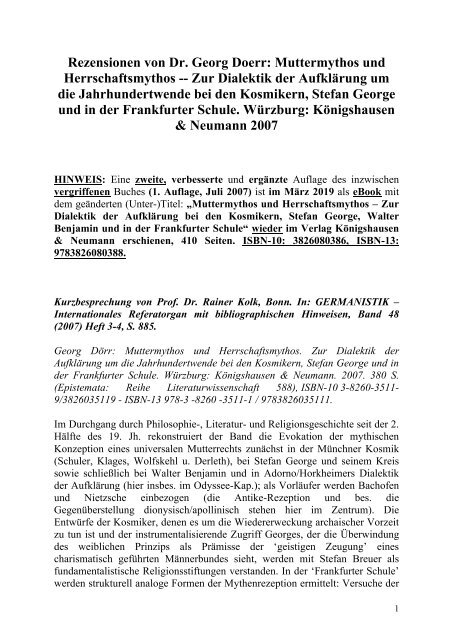

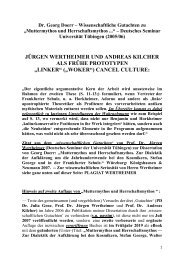

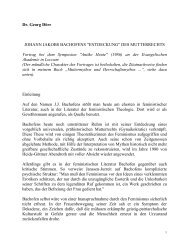
![Dr. Georg Doerr -- Kurzbesprechung von B. Röllin: Nietzsches Werkpläne vom Sommer 1885: eine Nachlass-Lektüre. Philologisch-chronologische Erschließung der Manuskripte. Fink: München [u.a.] 2012. Universität Basel, Diss., 2011.](https://img.yumpu.com/63036560/1/184x260/dr-georg-doerr-kurzbesprechung-von-b-rollin-nietzsches-werkplane-vom-sommer-1885-eine-nachlass-lekture-philologisch-chronologische-erschliessung-der-manuskripte-fink-munchen-ua-2012-universitat-basel-diss-2011.jpg?quality=85)


